Disability statistics - housing conditions
Data extracted in: November 2023.
Planned article update: December 2024.
Highlights
In 2022, 70 % of the EU population aged 16 years or over with a disability lived in a household that owned their own home, while 30 % lived in rented accommodation.
In 2022, the housing cost overburden rate for people in the EU with a disability was 10.6 % (ranging from 2.7 % in Cyprus to over 20 % in Denmark, Bulgaria and Greece), compared with 8 % for those with no disability.
Housing cost overburden rate for persons aged 16 years or over, by level of disability (activity limitation), 2022
This article is part of a set of articles on disability and presents various aspects of the housing conditions faced by people with a disability (activity limitation). The findings presented in this article are based on the European Union’s (EU) statistics on income and living conditions (EU-SILC). These are based on respondents’ assessments of their limitations in usual activities as well as their household’s housing situation. The data presented in this article generally cover persons aged 16 years or over. One analysis focuses specifically on persons aged 65 years or over.
In EU-SILC, disability is approximated according to the concept of global activity limitation, which is defined as a ‘limitation in activities people usually do because of health problems for at least the past six months’. This is considered to be an adequate proxy for disability, both by the scientific community and organisations representing people with disabilities. This definition is in also in line with the concept of disability as set out in the European disability strategy 2010–2020 and its successor, the Strategy for the rights of persons with disabilities 2021–2030.
Access to decent and affordable housing is a vital aspect of social policy. The importance of this has been reinforced by various crises in recent years, such as the global financial and economic crisis, the subsequent European sovereign debt crisis, and current concerns around the rising cost of living. Access to affordable, adequate housing has become increasingly difficult for households in many parts of the EU, especially among vulnerable population groups. The promotion of decent living conditions for persons with disabilities is a major objective of the Strategy for the rights of persons with disabilities 2021–2030.
Full article
Tenure status
In the EU as a whole, no major difference between people with or without a disability in terms of home ownership, but persons with a disability much less likely to have an outstanding loan or mortgage
In 2022, 70 % of people aged 16 years or over with a disability (some or severe activity limitation) in the EU lived in a household that owned their own home – see Table 1. Among people with a disability, 15.1 % were owners who still had a mortgage or loan to pay off and 54.9 % had no outstanding mortgage or housing loan. For comparison, 72.1 % of people aged 16 years or over with no disability lived in a household that owned their own home, 2.1 percentage points higher than the share for persons with a disability. Among people with no disability, 24.5 % still had a mortgage or loan to pay off, 9.4 percentage points higher than the share for persons with a disability. Consequently, the share of persons with no disability who had no outstanding mortgage (47.6 %) was lower than the share for persons with a disability. At least in part, these differences may reflect different age structures of the subpopulations of people with or with a disability which in turn impacts on the likelihood that people are at a stage of their lives when they have paid off any mortgages or house loans.
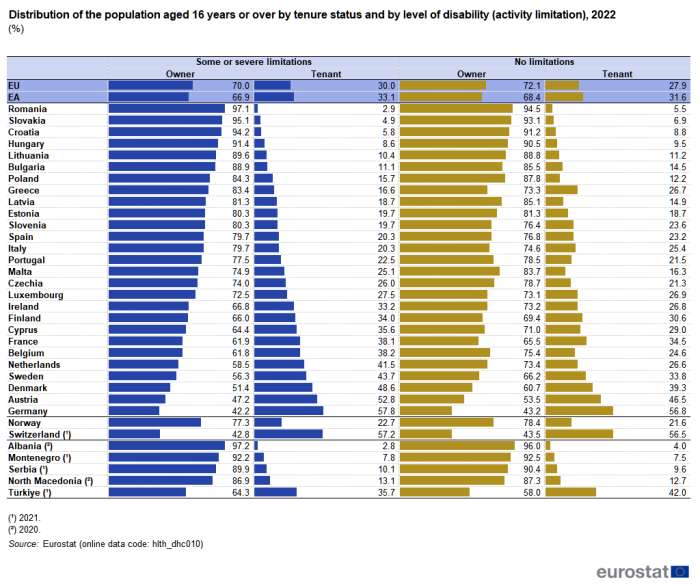
(%)
Source: Eurostat (hlth_dhc010)
Consequently, 30 % of people with a disability in the EU lived in rented accommodation in 2022: 17.3 % paid rent at the market rate and the remaining 12.7 % paid a reduced rent or no rent at all. For people without a disability, these figures were 18 % and 9.9 % respectively.
- The share of people without a disability paying a market price rent was 0.7 percentage points higher than the equivalent share for people with a disability.
- The share of people with a disability paying a reduced rent or no rent at all was 2.8 percentage points higher than the equivalent share for people without a disability.
With two exceptions, the EU Member States generally reported that over half of all people with a disability lived in owner-occupied dwellings in 2022 – see Table 1: in Austria, the share was 47.2 %, while it was 42.2 % in Germany. The highest share was 97.1 % in Romania.
In 17 EU Member States, the share of people living in owner-occupied dwellings was lower in 2022 among people with a disability than it was among people without a disability. By far the largest differences were in the Netherlands (where 58.5 % of people with a disability lived in owner-occupied dwellings, 14.9 percentage points lower than the equivalent share among people without a disability) and in Belgium (where 61.8 % of people with a disability lived in owner-occupied dwellings, 13.6 percentage points lower than the equivalent share among people without a disability). Among the 10 Member States where the share of people living in owner-occupied dwellings was higher among people with a disability, the largest difference was in Greece: the share among people with a disability was 83.4 %, some 10.1 percentage points more than the share among people without a disability.
Accommodation quality
People with a disability more often living in sub-standard accommodation
Across the EU, people with a disability were more likely to experience problems associated with housing deprivation – see Figure 1.
For three types of surveyed issues related to the area where people live, the issues were more common in 2021 among people with a disability.
- 21.4 % of people with a disability reported noise from neighbours or from the street, compared with 17 % of those not having a disability.
- 16.4 % of people with a disability reported pollution, grime or other environmental problems in the area where they lived, compared with 12.8 % among people without a disability.
- 14.1 % of people with a disability were aware of crime, violence or vandalism in the area where they lived, compared with 10.5 % among people without a disability.
Equally, all five issues related to the accommodation itself were more common among people with a disability; note the latest information available for this analysis refers to 2020.
- 18.6 % of people with a disability said they had a leaking roof, damp walls, floors or foundation, or rot in the window frames or floor in their home; among people without a disability the share was 13.5 %.
- 13.8 % of people with a disability reported that they were unable to keep their home adequately warm, compared with 8 % among people without a disability.
- 8.3 % of people with a disability complained of living in a dwelling considered too dark, compared with 6 % among people without a disability.
- 2.7 % of people with a disability had no indoor flushing toilet, compared with 1.8 % among people without a disability.
- 2.6 % of people with a disability had no bath or shower in their dwelling, compared with 1.6 % among people without a disability.
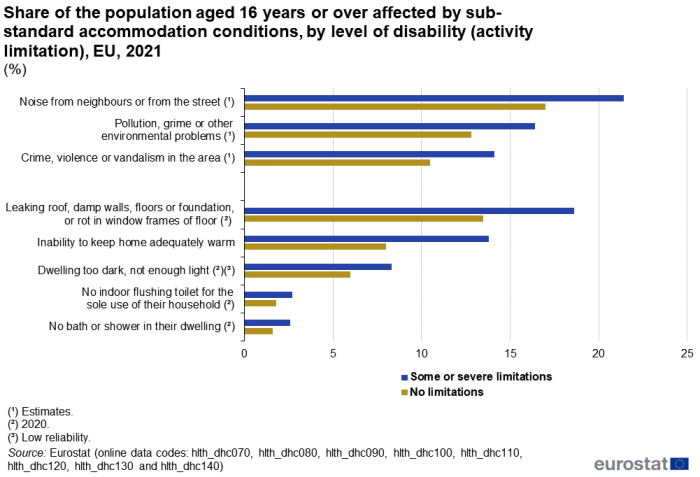
(%)
Source: Eurostat (hlth_dhc070), (hlth_dhc080), (hlth_dhc090), (hlth_dhc100), (hlth_dhc110), (hlth_dhc120), (hlth_dhc130) and (hlth_dhc140)
Overcrowding
People aged 16 years or over with a disability were less likely to live in an overcrowded household
Another indicator of housing quality is the number of people living in the same dwelling. The overcrowding rate is defined as the percentage of the population living in an overcrowded household. A household is overcrowded if it does not have at least one room for the household, one room per couple in the household, one room for each single person aged 18 years or over, one room per pair of single people of the same sex aged between 12 and 17 years, one room for each single person aged between 12 and 17 years and not included in the previous category, and one room per pair of children aged less than 12 years.
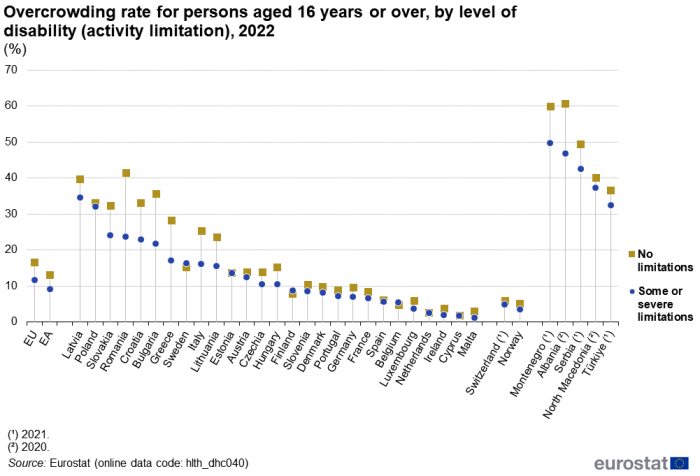
(%)
Source: Eurostat (hlth_dhc040)
In the EU in 2022, the overcrowding rate was lower for people with a disability than it was for people without a disability, the shares being 11.7 % and 16.6 %, respectively – see Figure 2. This situation was also observed in 23 of the EU Member States. The largest difference was recorded in Romania, where 23.7 % of people with a disability experienced overcrowding, 17.8 percentage points lower than the share among people without a disability (41.5 %). There were three Member States – Belgium, Finland and Sweden – where the overcrowding rate was higher for people with a disability, the differences in the rates for people with or without a disability were small, at most 1.2 percentage points (Sweden). In Cyprus, there was no difference in the overcrowding rate among those with or without a disability.
Among the EU Member States, the overcrowding rate in 2022 for people with a disability ranged from less than 2 % in Malta, Cyprus and Ireland to 32 % in Poland and 34.6 % in Latvia.
People aged 65 years or over with a disability more likely to experience overcrowding
A different pattern was observed among people aged 65 years or over – see Figure 3. In 2022, the overcrowding rate in the EU was higher for people with a disability (7.8 %) than for people without a disability (5.7 %).
This situation was also observed in 23 of the EU Member States. The largest difference was recorded in Latvia, where 27.2 % of people aged 65 years or over with a disability experienced overcrowding, 8 percentage points higher than the share among people aged 65 years or over without a disability (19.2 %). In the three Member States – Bulgaria, Malta and Croatia – where the overcrowding rate was lower for people aged 65 years or over with a disability, the differences in the rates for people aged 65 years or over with or without a disability were small, at most 1 percentage points (Croatia). In Denmark, there was no difference in the overcrowding rate for persons aged 65 years or more among those with or without a disability.
In 2022, the overcrowding rate for people with a disability ranged from 0.5 % in Malta to 26 % in Poland and 27.2 % in Latvia.
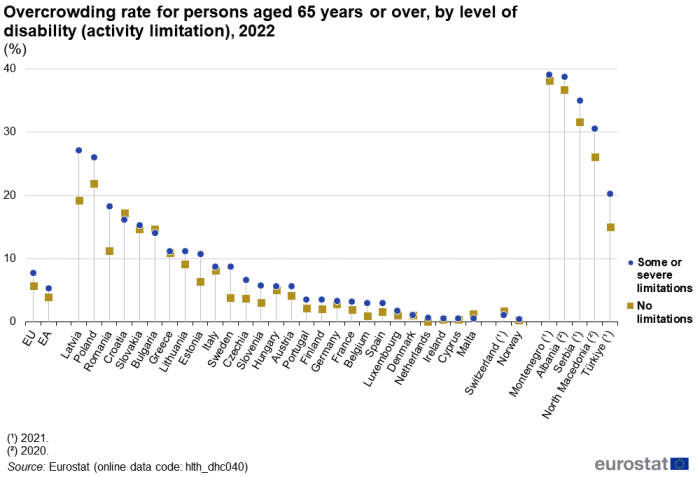
(%)
Source: Eurostat (hlth_dhc040)
Housing costs
People with a disability more likely to be overburdened by housing costs
Housing costs as a proportion of disposable income indicate people’s ability to afford the costs associated with their housing. Households with a higher income may find it easier to cope with a high share of housing costs in relation to their disposable income. Nevertheless, if housing costs are greater than or equal to 40 % of disposable income, this is deemed an overburden: the share of people whose housing costs meet this criterion is referred to as the housing cost overburden rate.
In general, housing costs include:
- mortgage interest and principal payments (for homeowners) and rental payments (for tenants),
- structural insurance, mandatory services and charges (for example, sewage or waste removal),
- the cost of utilities (such as water, electricity, gas and heating),
- regular maintenance and repairs to the dwelling,
- taxes (if applicable).
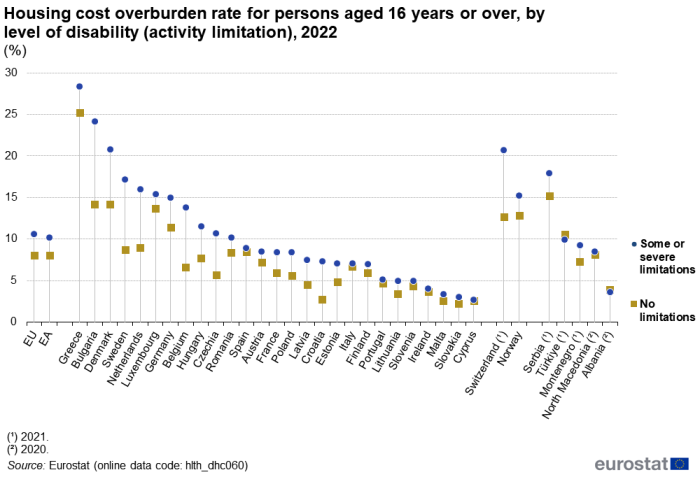
(%)
Source: Eurostat (hlth_dhc060)
In the EU, the housing cost overburden rate was 10.6 % in 2022 for people aged 16 years or over with a disability compared with 8 % for people without a disability. In every EU Member State, the housing cost overburden rate was higher among people with a disability than for people without a disability – see Figure 4. The largest gap was recorded in Bulgaria: the rate for people with a disability was 24.2 %, which was 10 percentage points higher than the rate for people without a disability (14.2 %).
Among the EU Member States, the housing cost overburden rate for people with a disability ranged in 2022 from 2.7 % in Cyprus to 20.8 % in Denmark, 24.2 % in Bulgaria and 28.4 % in Greece.
Source data for tables and graphs
Data sources
EU-SILC is the source of comparative statistics on income distribution and social inclusion in the EU. It provides annual data for the EU Member States as well as most EFTA and enlargement countries on income, poverty, social exclusion and other aspects of living conditions.
The reference population for EU-SILC is limited to private households and their current members residing in the territory of the surveying country at the time of data collection. People living in collective households and institutions are generally excluded from the reference population; this constitutes a limitation for disability statistics. All household members are surveyed, but only those aged 16 years or over are interviewed.
The source is documented in more detail in this background article which provides information on the scope of the data, its legal basis, the methodology employed, as well as related concepts and definitions.
Context
Disability statistics are used in measuring the impact and effectiveness of the EU policy aimed at ensuring equal rights for persons with disabilities. Up to now, the EU has adopted several strategies aimed at improving the lives of persons with disabilities by reducing discrimination, inequalities and supporting persons with disabilities to fully enjoy their human rights, fundamental freedoms and EU rights on an equal basis with others. In light of this, the 2021-2030 EU Strategy for the rights of persons with disabilities sets the EU objectives and action priorities in several areas, such as accessibility, citizens’ rights, quality of life, equal access and non-discrimination and the promotion of the rights of persons with disabilities. To find out more, please visit the webpage on the monitoring framework for the objectives and actions of this strategy.
To ensure sound monitoring and reporting of this topic, the European Commission is reinforcing the collection of data on the situation of persons with disabilities in areas where knowledge gaps have been identified, for example in relation to the labour market access.
The EU is also a signatory of the United Nations Convention on the Rights of Persons with Disabilities (CRPD).
Housing policy in EU Member States is a national policy, rather than an EU policy.
Direct access to
Other articles
Online publications
Related articles
- Health (hlth), see:
- Disability (hlth_dsb)
- Housing conditions of disabled people - EU-SILC survey (hlth_dsb_hcon)
- European Commission – Persons with disabilities, see:
- OECD – Housing
- United Nations – Convention on the Rights of Persons with Disabilities (CRPD)
- World Health Organization – Housing and health guidelines
- World Health Organization – International classification of functioning, disability and health (ICF)